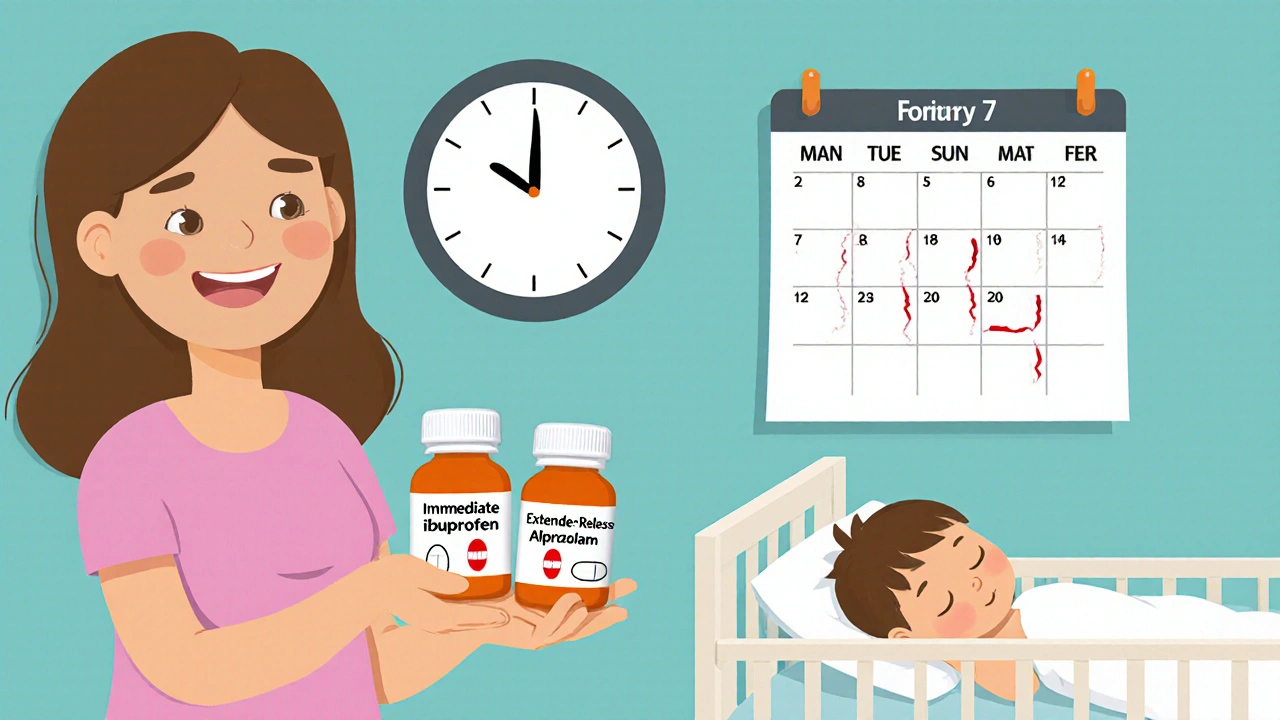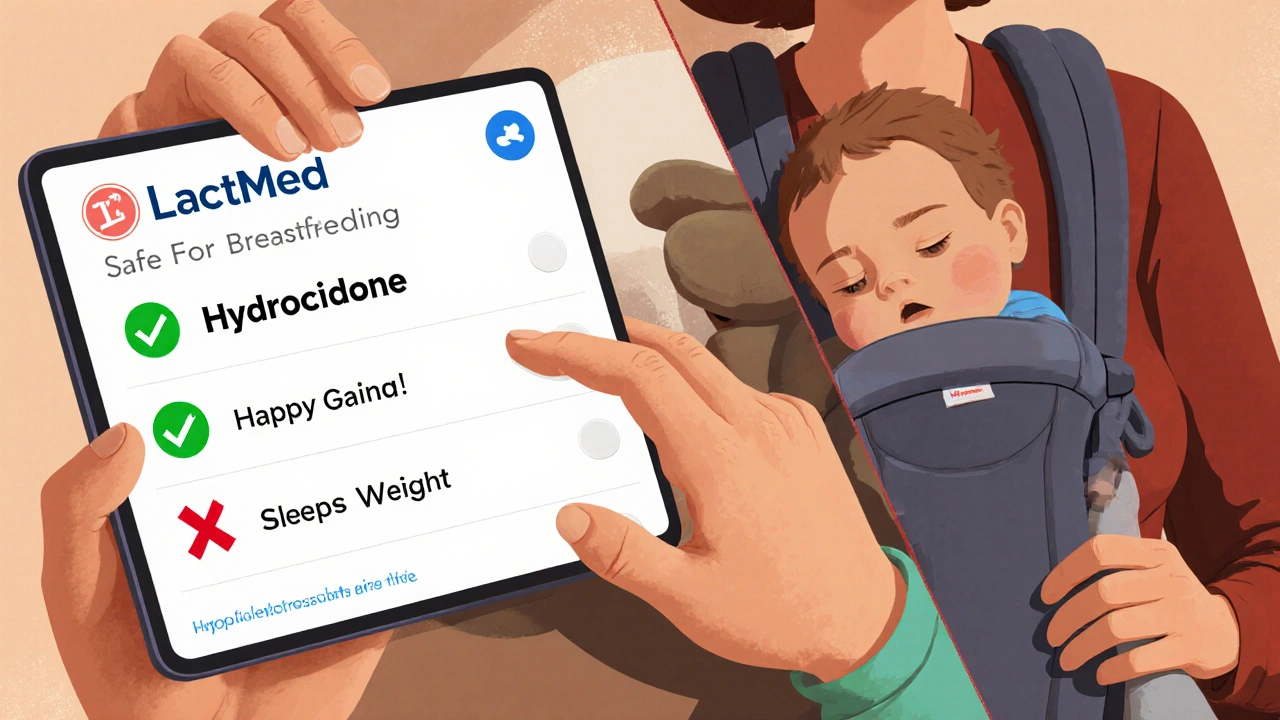How to Time Medication Doses to Reduce Infant Exposure During Breastfeeding

Many new mothers face a tough choice: take the medicine they need to feel better, or stop breastfeeding to protect their baby. The truth? Most medications are safe to use while breastfeeding-if you time them right. You don’t have to choose between your health and your baby’s nutrition. With the right strategy, you can keep nursing while keeping your baby’s exposure to drugs as low as possible.
Why Timing Matters More Than You Think
Medication doesn’t just disappear after you swallow it. It enters your bloodstream, then moves into your breast milk. The amount your baby gets depends on when you take the pill versus when they feed. If you take a dose right before nursing, your baby gets the highest concentration. But if you time it right, you can cut that exposure by half-or even more. The key is understanding peak concentration. That’s when the drug hits its highest level in your blood-usually 30 minutes to 2 hours after you take it. That’s also when it’s most likely to pass into your milk. By waiting to nurse until after that peak has passed, you give your body time to clear some of the drug.How to Time Doses for Single Daily Medications
If you’re only taking a medication once a day, the best time is right after your baby’s longest stretch of sleep. For most babies, that’s bedtime. So, if your baby sleeps 6-8 hours at night, take your dose right after the last feeding of the day. Here’s how it works:- Feed your baby at 8 PM.
- Take your medication right after.
- Let your baby sleep through the night.
- By morning, most of the drug has cleared from your system.
What to Do When You Need Multiple Doses a Day
If you’re on a medication that requires two or three doses daily, the rule is simple: breastfeed right before each dose. This gives your body the longest possible window to clear the drug before the next feeding. For example:- Feed at 7 AM → take medication at 8 AM
- Feed at 1 PM → take medication at 2 PM
- Feed at 7 PM → take medication at 8 PM
Medications That Need Special Care
Not all drugs behave the same. Some have long half-lives, meaning they stick around in your body for days. For these, timing barely helps. Avoid these if possible:- Fluoxetine (Prozac) - Half-life: 96 hours. Active metabolite lasts over 260 hours. Accumulates in breast milk. Avoid unless no other option.
- Diazepam (Valium) - Half-life: 44-48 hours. Can cause sedation in infants. Even with timing, babies can still get high exposure.
- Sertraline - Half-life: 26 hours. Low transfer to milk. First choice for breastfeeding mothers with depression.
- Lorazepam - Half-life: 10-20 hours. Much safer than diazepam. Lower infant exposure.
- Prednisone - At standard doses, almost no transfer. For high doses (over 20 mg/day), wait 4 hours after taking it before nursing.
Extended-Release vs. Immediate-Release
If you have a choice, always pick immediate-release over extended-release versions. Why? Extended-release pills are designed to release slowly over hours. That means your blood levels stay high longer-and so does the amount in your milk. For example:- Immediate-release alprazolam peaks in 1-2 hours.
- Extended-release alprazolam peaks at 9 hours.

What About Hormonal Birth Control?
Many mothers wonder if they can start birth control while breastfeeding. The answer depends on the type.- Combination pills (estrogen + progestin) - Avoid for at least 3-4 weeks after birth. Estrogen can reduce milk supply.
- Progestin-only pills (mini-pill) - Safe to start as early as 6 weeks postpartum. Doesn’t affect milk supply.
- Implants or IUDs - Also safe. No impact on breastfeeding.
What About Newborns, Preemies, or Sick Babies?
Infants under 6 weeks old-especially preemies or those with liver or kidney issues-are less able to process medications. Their bodies can’t clear drugs as quickly as older babies. For these babies, timing becomes even more critical. Even medications that are normally safe may need extra caution. Your pediatrician may recommend:- Waiting longer between dose and feed (up to 4-6 hours)
- Using lower doses
- Switching to a safer alternative
When to Pump and Dump
Some mothers panic and pump and dump after every dose. But that’s usually unnecessary. Pumping and dumping only makes sense in rare cases:- You’re taking a medication that’s known to be unsafe (like chemotherapy drugs)
- You’re having a one-time procedure with strong pain meds (like surgery)
- You’re on a short-term course of a drug with a long half-life and can’t delay it
Tools to Help You Get It Right
You don’t have to guess. There are trusted resources that give you exact timing advice for almost every medication:- LactMed - A free database from the National Library of Medicine. Updated monthly. Search any drug and get peak times, half-lives, and breastfeeding safety ratings.
- Hale’s Medication and Mothers’ Milk - The gold standard reference. Uses the RID system and categorizes drugs by safety level.
- LactMed App - Available on iOS and Android. 127,000+ users as of 2023. Works offline.

What to Watch For in Your Baby
Even with perfect timing, keep an eye out for signs your baby might be reacting to the medication:- Unusual sleepiness or difficulty waking to feed
- Poor feeding or refusing the breast
- Excessive fussiness or irritability
- Changes in weight gain
- Jaundice that won’t clear
Real Stories, Real Results
One mother in Sydney, new to breastfeeding, was prescribed sertraline for postpartum anxiety. She was terrified. Her doctor showed her how to nurse right before her 8 AM and 8 PM doses. Within a week, her baby was feeding normally, gaining weight, and sleeping well. She’s now 6 months postpartum and still breastfeeding. Another mom had to take hydrocodone after a C-section. She pumped 8 ounces before surgery, fed her 6-month-old stored milk for 4 hours after, then resumed breastfeeding. No issues. These aren’t rare cases. A 2022 survey of 157 lactation consultants found 87% of mothers using hydrocodone with proper timing had no problems. Only 42% of those using diazepam succeeded-because timing doesn’t fix long half-lives.The Bigger Picture
Breastfeeding isn’t just nutrition. It’s immunity, bonding, and long-term health for your baby. And your mental and physical health matter too. You don’t have to suffer in silence or quit nursing to take care of yourself. The science is clear: with the right timing, 98% of medications can be used safely during breastfeeding. You don’t need to be a pharmacologist. Just follow these simple rules:- Nurse right before you take your dose
- Take once-daily meds after the longest sleep
- Choose immediate-release over extended-release
- Avoid fluoxetine and diazepam if you can
- Use LactMed to check every new drug
Can I breastfeed after taking painkillers like ibuprofen or acetaminophen?
Yes. Both ibuprofen and acetaminophen are considered safe during breastfeeding. They transfer in very small amounts to breast milk. For best results, take them right after nursing, especially if you’re taking them once a day. Their short half-lives (2-4 hours) mean they clear quickly, so your baby gets minimal exposure.
What if my baby sleeps through the night? Should I wake them to feed before I take my medicine?
No. Don’t wake your baby to feed before a dose. It’s more important to let them sleep. Instead, take your medication right after their last feeding before bedtime. That way, you’re still minimizing exposure without disrupting their sleep or your rest. Babies naturally stretch out feedings as they grow-this timing works perfectly with that pattern.
Is it safe to take antidepressants while breastfeeding?
Yes, many are. Sertraline and paroxetine are the most recommended because they transfer in very low amounts to breast milk. Fluoxetine should be avoided due to its extremely long half-life. Always work with your doctor to pick the safest option and time doses right after nursing. Studies show 92% of mothers on SSRIs successfully continue breastfeeding with proper timing.
How long should I wait after taking a medication before breastfeeding?
It depends on the drug. For most short-acting medications, wait 2-4 hours after taking it. But the better strategy is to nurse right before taking the dose. That way, your body has time to clear the drug during the next feeding window. For drugs with long half-lives, timing won’t help much-so avoid them if possible.
Does pumping and dumping reduce drug exposure in breast milk?
Only in rare cases. Pumping and dumping doesn’t speed up how fast your body clears the drug-it just removes milk that already contains it. For short-acting drugs, it’s usually unnecessary. For long-acting drugs, it won’t help much either. It’s better to time your doses correctly. Only use pumping and dumping for one-time exposures like surgery or chemotherapy.
What if I’m taking multiple medications at once?
Check each one individually using LactMed or Hale’s reference. Some drugs interact in ways that increase milk transfer. If you’re on more than two medications, talk to a lactation consultant or pharmacist. They can help you prioritize which ones are safest and how to space them out. Never assume all medications are safe just because each one is individually approved.
Are over-the-counter cold medicines safe while breastfeeding?
Most single-ingredient cold medicines are safe. Avoid multi-symptom formulas with decongestants like pseudoephedrine, which can reduce milk supply. Stick to plain acetaminophen for fever, saline nasal sprays, and honey-based cough syrups (for babies over 1 year). Always check the active ingredients on LactMed before taking anything.
What to Do Next
If you’re currently taking medication and breastfeeding:- Write down every medication you’re on-prescription, OTC, and supplements.
- Look each one up on LactMed (free online or app).
- Identify which ones need timing adjustments.
- Plan your feeding and dosing schedule around your baby’s sleep pattern.
- Talk to your doctor or a lactation consultant to confirm your plan.

Deepak Mishra
November 16, 2025 AT 08:19Latrisha M.
November 17, 2025 AT 08:49John Mwalwala
November 18, 2025 AT 00:08Daniel Stewart
November 19, 2025 AT 23:42Jamie Watts
November 21, 2025 AT 00:51Rachel Wusowicz
November 21, 2025 AT 23:57Diane Tomaszewski
November 23, 2025 AT 05:18Dan Angles
November 24, 2025 AT 02:51David Rooksby
November 25, 2025 AT 12:04Melanie Taylor
November 26, 2025 AT 09:48Teresa Smith
November 27, 2025 AT 20:29ZAK SCHADER
November 28, 2025 AT 16:00Danish dan iwan Adventure
November 28, 2025 AT 18:47Ankit Right-hand for this but 2 qty HK 21
November 28, 2025 AT 23:09